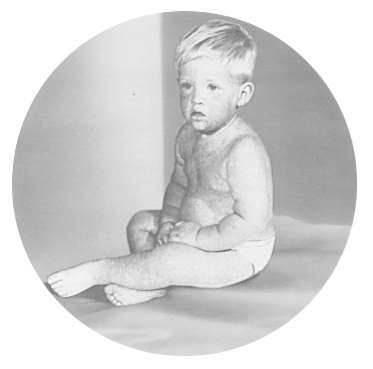Measles
Background
Measles is caused by a single-stranded, enveloped RNA virus, Morbillivirus hominis, in the Paramyxoviridae family of viruses. Humans are the only natural hosts of this virus, but other Morbillivirus species cause canine distemper in dogs and Rinderpest in cattle.
Documented cases of measles date back to at least the ninth century. National reporting of diagnosed measles cases became mandatory in the U.S. in 1912, and it was found that measles was responsible for an average of 6,000 deaths per year for the first ten years of reporting.
Measles vaccines have been available since 1963. The combined measles, mumps, and rubella vaccine (MMR) has been available since the early 1970s. Widespread vaccination and improved sanitary conditions have drastically reduced disease rates in the U.S. and abroad. Globally, measles deaths decreased dramatically between 2000 and 2016, but are still common in many developing countries, particularly those in Africa, Southeast Asia, and the Eastern Mediterranean. An estimated 107,500 people died from the measles infection in 2023. The overwhelming majority of measles deaths (more than 90%) occur in countries with inadequate healthcare infrastructure.
Measles was thought to have been eliminated from the U.S. in 2000. However, outbreaks in other countries (e.g., England, France, Germany, India, Israel, the Philippines, and Vietnam) and the uptick in global travel have increased the spread of measles in U.S. communities.
Between 2014 and 2024, there was an average of about 300 reported measles infections every year, but this number varied widely from year to year, ranging from 13 cases in 2020 to 1274 cases in 2019. Measles infections among workers have also been reported. For example, between 2001 and 2014, 29 healthcare workers were infected with measles as a result of occupational exposures in U.S. facilities.
Transmission and Symptoms
Transmission
Measles is a respiratory illness and spreads through the air or through contact with infected respiratory secretions and saliva. Infected people can release the virus into the air when they breathe, cough, or sneeze. Infectious viral particles released into the air may be inhaled by others or can settle on nearby surfaces. The measles virus is very contagious and can survive and remain infectious in the air or on surfaces for up to two hours. Anyone close to an infectious person who is not immune can become infected. The illness usually begins between 7 and 14 days after exposure to the virus.
Symptoms
Measles typically begins with a high fever, cough, runny nose, and conjunctivitis (red, watery eyes), which lasts between 2-4 days. Tiny white spots, called Koplic spots, appear in the mouth about 2-3 days after other symptoms begin, followed by the development of the measles rash (3-5 days after initial symptoms begin), which often coincides with a spike in fever. Characteristics of the measles rash include:
- Flat red spots, which begin on the face, then spread downward to the trunk and limbs
- Red spots may have small, raised bumps and may join together
- Spots last for 5-6 days
People infected with measles are contagious from the four days before the rash appears through the four days after the rash appears. However, some immunocompromised people (i.e., those with weakened immune systems) may be able to spread the virus until they fully recover.
Complications
While complications from measles, some very serious, can affect anyone who becomes ill, they are more dangerous in those who are pregnant or have weakened immune systems. According to the CDC, one in every five unvaccinated people with measles is hospitalized with disease complications. These and other complications may include:
- Bronchitis, laryngitis, or croup
- Ear infection (leading to deafness)
- Diarrhea and vomiting (leading to dehydration)
- Pneumonia
- Encephalitis
As with all respiratory illnesses, a secondary viral or opportunistic bacterial infection can occur, leading to pneumonia, which can be life-threatening for people with weakened immune systems.
The most serious complication-- encephalitis-- an infection and swelling of the brain, is rare and occurs in only 1 of every 1000 measles patients (0.1%). Primary encephalitis occurs at the time the patient is experiencing symptoms. Encephalitis can also occur after symptoms have cleared and may be acute (sudden and intense) or chronic (slow to appear). The chronic encephalitis caused by measles infection is rare and can occur 7-10 years after measles illness.
Another complication from measles affects the immune system’s ability to fight off other infections. It is known as “immune amnesia” where immune memory against other diseases is wiped out, leaving one vulnerable to infections. This effect may last between 2 and 3 years after measles.


